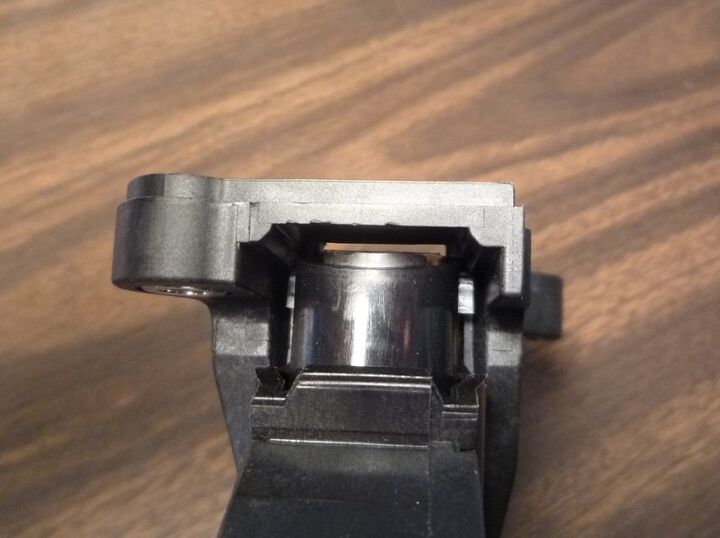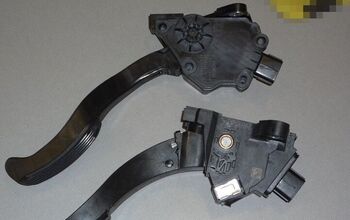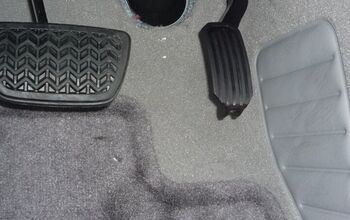Toyota Gas Pedal Fix Simulated: Friction Reduced, But By Too Much?

Update: a portal to all of TTAC’s articles on the subject of Toyota gas pedals is here:
We’ve taken it apart, explained Toyota’s intended fix, and now we’ve replicated the “fix” to see what effect it has. It works, but does it work too well?
In the photo above, the two friction teeth are shown in their operating position before the “fix”. One can easily see their pivot axle sticking out to both sides, in a lighter gray color, just where the friction unit protruded from the housing. The other end of this friction unit is the retainer for the return spring, and this is what creates the pressure on the friction teeth.
The second picture (above) shows the other end of this unit. The round end in the middle of the unit is where the coil spring is retained. The gap as shown in this picture is where the metal spacer would go. It would change the fulcrum angle, and the amount of pressure that the spring would exert on the friction teeth.
In the third picture (above) we have inserted a 1/8″ thick screwdriver shank to simulate a spacer in this area. We don’t know yet what thickness the Toyota space will have, so this is an arbitrary guess to see the effect. The amount of friction was substantially reduced by this increase in the gap, and the change in the fulcrum angle of the friction bar unit. We were not able to actually install the unit in a car to see how it would feel, but the change in feel was very noticeable to the hand.
As we’ve explained in the prior post, the balance of friction to the control spring is what creates a stable, yet safe pedal assembly. By reducing the friction, the pedal will feel “less stable”, and it might be more difficult to maintain a steady throttle opening. The perceived pressure felt by the foot will also be greater. The degree of this affect will of course depend on the thickness of the spacer Toyota specifies.
Undoubtedly, this fix will profoundly reduce the likelihood or possibility of the pedal being stuck or slow to return. But the trade off may not be immaterial. Undoubtedly, Toyota’s intended degree of friction will be compromised by this fix, to one degree or another. And drivers may find the fix unpleasant or uncomfortable, also to some degree or another. Clearly, this fix is a band aid to fix the intrinsic limitations of this design. We will be taking a closer look at the Denso pedal next to see how their design is different.
Update: The final article in this series compares the two pedals (CTS and Denso), and makes a recommendation. Link here.

More by Paul Niedermeyer
Latest Car Reviews
Read moreLatest Product Reviews
Read moreRecent Comments
- Spectator Lawfare in action, let’s see where this goes.
- Zerocred I highly recommend a Mini Cooper. They are fun to drive, very reliable, get great gas mileage, and everyone likes the way they look.Just as an aside I have one that I’d be willing to part with just as soon as I get the engine back in after its annual rebuild.
- NJRide Any new Infinitis in these plans? I feel like they might as well replace the QX50 with a Murano upgrade
- CaddyDaddy Start with a good vehicle (avoid anything FCA / European and most GM, they are all Junk). Buy from a private party which allows you to know the former owner. Have the vehicle checked out by a reputable mechanic. Go into the situation with the upper hand of the trade in value of the car. Have the ability to pay on the spot or at you bank immediately with cash or ability to draw on a loan. Millions of cars are out there, the one you are looking at is not a limited commodity. Dealers are a government protected monopoly that only add an unnecessary cost to those too intellectually lazy to do research for a good used car.
- Redapple2 I gave up on Honda. My 09 Accord Vs my 03. The 09s- V 6 had a slight shudder when deactivating cylinders. And the 09 did not have the 03 's electro luminescent gages. And the 09 had the most uncomfortable seats. My brother bought his 3rd and last Honda CRV. Brutal seats after 25 minutes. NOW, We are forever Toyota, Lexus, Subaru people now despite HAVING ACCESS TO gm EMPLOYEE DISCOUNT. Despite having access to the gm employee discount. Man, that is a massive statement. Wow that s bad - Under no circumstances will I have that govna crap.





































Comments
Join the conversation
Does anyone know if this fix affects accelleration? My 2009 5 speed manual(not fixed) was much quicker than my 2010 5 speed manual.
The 2009 had 28k on it. The 2010 has 1700. The pickup in the higher gears is no way near the old one(which was unfortunately totaled in an accident).